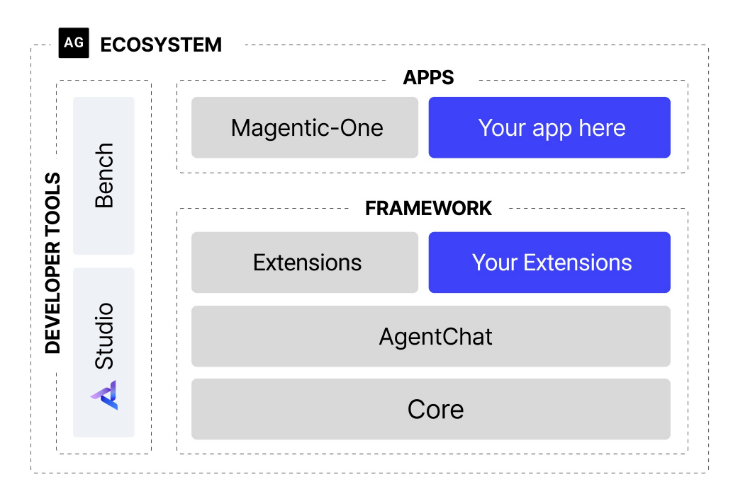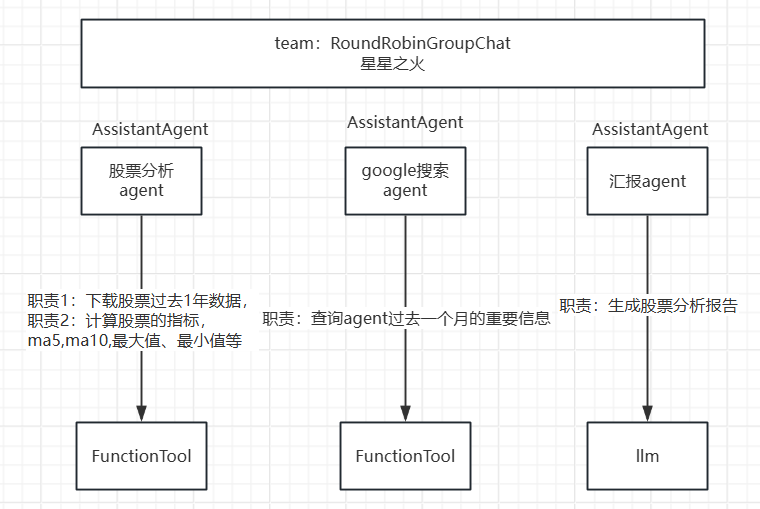【GPT入门】第71课 autogen介绍与代码实现股票分析汇报多智能体
【GPT入门】第71课 autogen介绍与代码实现股票分析汇报多智能体
- 1. autogen介绍
- 1.1 autogen介绍
- 1.2 特点
- 2. 安装
- 3. 股票分析的多agent代码实践
- 3.1 agent设计思路
- 3.2 代码实现
- 4. autogen studio
AutoGen是微软公司发布的一个开源编程框架,旨在通过多智能体协作来构建基于大语言模型的下一代应用程序。以下是其详细介绍和特点:
1. autogen介绍
1.1 autogen介绍
AutoGen的核心在于支持多个Agent之间的互动合作,以解决复杂的任务。每个Agent都可以被定制,以扮演不同的角色,例如程序员、公司高管或设计师等。通过这种方式,AutoGen使得大模型能够模拟人类间的对话和协作,从而高效地处理工作流。
除了AutoGen框架本身,微软还推出了AutoGen Studio,这是一个更为直观的工具,它为用户提供了一个可视化界面,用以定义、修改智能体参数,与智能体交互,添加技能,并管理会话。AutoGen的应用场景非常广泛,包括自动化文档生成、多智能体协作的客户服务、数据分析和报告,以及个性化学习等。
AUTOGEN 架构

1.2 特点
- 可定制的智能体:开发者可以定义不同角色和能力的智能体,如AssistantAgent、UserProxyAgent、TeachableAgent等,每个智能体都能根据需求被赋予特定的功能和行为模式。
- 多智能体协作:支持多种交互模式,如双人对话、顺序聊天、群聊等,群聊由管理者协调,能够模拟人类团队的协作方式,将复杂任务分解为多个子任务,由不同智能体分别处理,提高任务处理效率。
- 工具集成:智能体可以调用外部工具,如代码执行、API调用、数据库查询等,从而扩展了智能体的功能,使其能够更好地处理各种实际任务。
- 人类参与:支持“人在回路”,允许人类提供反馈或干预,使得系统在运行过程中能够结合人类的智慧和判断,提高结果的准确性和可靠性。
- 异步与可扩展架构:最新版本采用异步、事件驱动架构,支持分布式系统和跨语言开发,如Python和.NET,这使得AutoGen能够适应不同的开发环境和需求,具有良好的扩展性和性能表现。
- 低代码接口:通过AutoGen Studio提供无代码或低代码界面,降低了开发门槛,即使是非专业的开发者也能够轻松上手,快速构建基于智能体的应用程序。
2. 安装
参考官网:https://github.com/microsoft/autogen
官网建议python版本3.10及以上, 这里使用3.11,参考前面的文章安装conda环境
# Install AgentChat and OpenAI client from Extensions
pip install -U "autogen-agentchat" "autogen-ext[openai]"
# Install AutoGen Studio for no-code GUI
pip install -U "autogenstudio"
3. 股票分析的多agent代码实践
3.1 agent设计思路
设计思路: 设计一个team: team由3个agent组成,分别是 股票分析agent、google搜索agent、股票分析汇报agent,执行顺序是依次。

3.2 代码实现
- 导包
from autogen_agentchat.agents import AssistantAgent
from autogen_agentchat.conditions import TextMentionTermination
from autogen_agentchat.teams import RoundRobinGroupChat
from autogen_agentchat.ui import Console
from autogen_core.tools import FunctionTool
from autogen_ext.models.openai import OpenAIChatCompletionClientimport osos.environ["GOOGLE_API_KEY"] = "AIzaSyChLbcLjXwSSssuzXzjchqA5E_t4aEDWp4"
os.environ["GOOGLE_SEARCH_ENGINE_ID"] = "961e69d5fd62145b2"
- 编写function
#!pip install yfinance matplotlib pytz numpy pandas python-dotenv requests bs4def google_search(query: str, num_results: int = 2, max_chars: int = 500) -> list: # type: ignore[type-arg]import osimport timeimport requestsfrom bs4 import BeautifulSoupfrom dotenv import load_dotenvload_dotenv()api_key = os.getenv("GOOGLE_API_KEY")search_engine_id = os.getenv("GOOGLE_SEARCH_ENGINE_ID")if not api_key or not search_engine_id:raise ValueError("API key or Search Engine ID not found in environment variables")url = "https://customsearch.googleapis.com/customsearch/v1"params = {"key": str(api_key), "cx": str(search_engine_id), "q": str(query), "num": str(num_results)}response = requests.get(url, params=params)if response.status_code != 200:print(response.json())raise Exception(f"Error in API request: {response.status_code}")results = response.json().get("items", [])def get_page_content(url: str) -> str:try:response = requests.get(url, timeout=10)soup = BeautifulSoup(response.content, "html.parser")text = soup.get_text(separator=" ", strip=True)words = text.split()content = ""for word in words:if len(content) + len(word) + 1 > max_chars:breakcontent += " " + wordreturn content.strip()except Exception as e:print(f"Error fetching {url}: {str(e)}")return ""enriched_results = []for item in results:body = get_page_content(item["link"])enriched_results.append({"title": item["title"], "link": item["link"], "snippet": item["snippet"], "body": body})time.sleep(1) # Be respectful to the serversreturn enriched_resultsdef analyze_stock(ticker: str) -> dict: # type: ignore[type-arg]import osfrom datetime import datetime, timedeltaimport matplotlib.pyplot as pltimport numpy as npimport pandas as pdimport yfinance as yffrom pytz import timezone # type: ignorestock = yf.Ticker(ticker)# Get historical data (1 year of data to ensure we have enough for 200-day MA)end_date = datetime.now(timezone("UTC"))start_date = end_date - timedelta(days=365)hist = stock.history(start=start_date, end=end_date)# Ensure we have dataif hist.empty:return {"error": "No historical data available for the specified ticker."}# Compute basic statistics and additional metricscurrent_price = stock.info.get("currentPrice", hist["Close"].iloc[-1])year_high = stock.info.get("fiftyTwoWeekHigh", hist["High"].max())year_low = stock.info.get("fiftyTwoWeekLow", hist["Low"].min())# Calculate 50-day and 200-day moving averagesma_50 = hist["Close"].rolling(window=50).mean().iloc[-1]ma_200 = hist["Close"].rolling(window=200).mean().iloc[-1]# Calculate YTD price change and percent changeytd_start = datetime(end_date.year, 1, 1, tzinfo=timezone("UTC"))ytd_data = hist.loc[ytd_start:] # type: ignore[misc]if not ytd_data.empty:price_change = ytd_data["Close"].iloc[-1] - ytd_data["Close"].iloc[0]percent_change = (price_change / ytd_data["Close"].iloc[0]) * 100else:price_change = percent_change = np.nan# Determine trendif pd.notna(ma_50) and pd.notna(ma_200):if ma_50 > ma_200:trend = "Upward"elif ma_50 < ma_200:trend = "Downward"else:trend = "Neutral"else:trend = "Insufficient data for trend analysis"# Calculate volatility (standard deviation of daily returns)daily_returns = hist["Close"].pct_change().dropna()volatility = daily_returns.std() * np.sqrt(252) # Annualized volatility# Create result dictionaryresult = {"ticker": ticker,"current_price": current_price,"52_week_high": year_high,"52_week_low": year_low,"50_day_ma": ma_50,"200_day_ma": ma_200,"ytd_price_change": price_change,"ytd_percent_change": percent_change,"trend": trend,"volatility": volatility,}# Convert numpy types to Python native types for better JSON serializationfor key, value in result.items():if isinstance(value, np.generic):result[key] = value.item()# Generate plotplt.figure(figsize=(12, 6))plt.plot(hist.index, hist["Close"], label="Close Price")plt.plot(hist.index, hist["Close"].rolling(window=50).mean(), label="50-day MA")plt.plot(hist.index, hist["Close"].rolling(window=200).mean(), label="200-day MA")plt.title(f"{ticker} Stock Price (Past Year)")plt.xlabel("Date")plt.ylabel("Price ($)")plt.legend()plt.grid(True)# Save plot to fileos.makedirs("coding", exist_ok=True)plot_file_path = f"coding/{ticker}_stockprice.png"plt.savefig(plot_file_path)print(f"Plot saved as {plot_file_path}")result["plot_file_path"] = plot_file_pathreturn result- 定义function tool
google_search_tool = FunctionTool(google_search, description="Search Google for information, returns results with a snippet and body content"
)
stock_analysis_tool = FunctionTool(analyze_stock, description="Analyze stock data and generate a plot")- 定义client
from autogen_core.models import ModelFamily
model_client = OpenAIChatCompletionClient(model="deepseek-chat",base_url="https://api.deepseek.com/v1",api_key="sk-改为自己的key",model_info={"vision": False,"function_calling": True,"json_output": False,"family": ModelFamily.R1,},)
- 组建team
# model_client = OpenAIChatCompletionClient(model="gpt-4o")search_agent = AssistantAgent(name="Google_Search_Agent",model_client=model_client,tools=[google_search_tool],description="Search Google for information, returns top 2 results with a snippet and body content",system_message="You are a helpful AI assistant. Solve tasks using your tools.",
)stock_analysis_agent = AssistantAgent(name="Stock_Analysis_Agent",model_client=model_client,tools=[stock_analysis_tool],description="Analyze stock data and generate a plot",system_message="Perform data analysis.",
)report_agent = AssistantAgent(name="Report_Agent",model_client=model_client,description="Generate a report based the search and results of stock analysis",system_message="You are a helpful assistant that can generate a comprehensive report on a given topic based on search and stock analysis. When you done with generating the report, reply with TERMINATE.",
)
team = RoundRobinGroupChat([stock_analysis_agent, search_agent, report_agent], max_turns=3)
- 启动agent
stream = team.run_stream(task="Write a financial report on American airlines")
await Console(stream)await model_client.close()4. autogen studio
可以使用可视化页面做上面代码的功能
